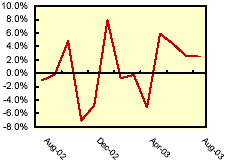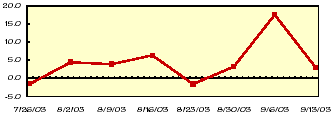



Poultry Outlook Report - September 2003
By U.S.D.A., Economic Research Service - This article is an extract from the September 2003: Livestock, Dairy and Poultry Outlook Report, highlighting Global Poultry industry data. This report indicates, broiler meat production during the second half of 2003 is expected to be slightly higher than during the same period in 2002.| Broiler Production Forecast Increased |

|
Composite Broiler Price
Percent change from previous month 
|
|
Weekly Broiler Slaughter
Percent change from last year 
|
The U.S. broiler production forecast for third quarter 2003 has been increased to 8.43 billion pounds, up 150 million pounds from the previous estimate. This is a 2.1-percent increase in production compared to a year earlier and reflects an expected upward turn in the number of birds slaughtered as well as continued growth in their average weight. Broiler meat production is expected to show a seasonal decline in the fourth quarter, with production estimated at 8.1 billion pounds.
Throughout most of the third quarter, the number of chicks being placed for growout has averaged only marginally higher than the previous year. This pattern is expected to change slightly going into the fourth quarter, with chick placements averaging slightly less than 1 percent higher than the previous year. In the most recent broiler hatchery report, the number of egg sets and chicks placed over the last 5 weeks (August 2 to September 6) showed little growth over the previous year.
This is a strong indication that the number of birds available to processors through the middle of November will at best be only a little higher than in the same period in 2002. However, average live weights have continued to increase and are expected to be a major reason behind higher broiler meat production. Over the first 7 months of 2003, the number of birds slaughtered was down by 1.4 percent, but that decline was has been offset by a 1.4-percent increase in their average weights.
| Broiler Exports Edge Higher |
Second quarter 2003 broiler exports totaled 1.17 billion pounds, up 2.6 percent from the same period in 2001. The chief reason for the increase is a stabilization in the export situation with Russia. Exports to Russia were down 10.5 percent over the first 7 months of 2003, compared with same period in 2002. This amounts to a roughly 100-millionpound decrease in shipments. However, all the decrease was in the first quarter, with shipments in the remaining months slightly higher than the previous year.
Shipments to other top markets (Hong Kong, Mexico, and Korea) have also been markedly lower than the previous year. These have been almost totally offset by the growth in exports to a number of rapidly growing markets. In the Western Hemisphere, much of the growth has been in shipments to Cuba (up 62 percent) and Guatemala (up 30 percent). Other high-growth areas so far in 2003 have been direct shipments to China (up 104 percent), Angola (up 40 percent), and Taiwan (up 40 percent).
The forecast for broiler exports during the second half of 2003 calls for gradually increasing shipments. Total exports in the third and fourth quarters are expected to reach 2.6 billion pounds, up 5 percent from the previous year. Along with improvements in the Russian market, this forecast depends on improvements in exports to such markets as Hong Kong and Mexico.
| Flat Production, But Lower Exports, Increases Turkey Stocks |
|
Retail Turkey Price
Percent change from previous month 
|
|
Weekly Turkey Slaughter
Percent change from last year 
|
Cold storage estimates at the beginning of August place turkey stocks at 742 million pounds, 5 percent higher than in 2002, but 39 percent higher than at the beginning of August 2001. Overall, most of the increase in turkey stocks has been in parts, which are 9 percent higher than at the same time the previous year. While stocks of whole birds are up only 1.4 percent, there is a large difference between the poundage of whole hen and whole toms in storage. Stocks of whole toms are up 14 percent from the previous year, but have been offset almost entirely by lower cold storage holding of whole hens (down 13.3 percent).
| Egg Prices Up Sharply |
In August 2003, wholesale table egg prices (NY grade A large) averaged 93.8 cents per dozen, the highest ever recorded since the series started in 1970. For all 2003, prices are expected to average 81- 83 cents a dozen, the highest since 1996, when wholesale prices averaged 88.2 cents per dozen, also the highest annual price ever recorded. In 1996, large export sales and the rising trend of eating breakfast out were major contributors to high egg prices.
In 2003, however, high egg prices are likely due to tighter per capita supplies, resulting from poor profitability during 1999-2002, flocks depopulations, and rising demand for eggs that are “animal care certified.” In response to concerns about animal welfare, the U.S. United Egg Producers (UEP) voluntarily initiated, without government mandates or intervention, industrywide Animal Husbandry Guidelines that will begin first by increasing the assigned cage space per bird over several years. The Food Marketing Institute and the National Council of Chain Restaurants have endorsed these guidelines. Most grocery chains in the United States are requiring suppliers to be certified as using the guidelines.
In August 2002, the U.S. egg industry started with an initial space allowance of 56 sq. inches for white egg leghorn layers, and 62 sq. inches for brown egg layers. These space allowances, according to UEP, will increase gradually to a maximum of 67 sq. inches for white layers and 76 sq. inches for brown layers in 2008. Increased cage space allowance has pushed the production costs upwards especially those of buildings, installation, and equipment, as well as feed. With larger cages the feed conversion improved, egg production rose, and birds require more energy feed to produce the extra eggs and for relatively more movement within the cage.
However, despite higher total feed costs, feed cost per egg is probably less. According to UEP, as of June 1, 2003, most egg-producing companies (82% of the industry) were implementing these welfare guidelines.
Wholesale egg prices increased sharply from an average of 67.7 cents per dozen in May to 93.8 cents in August (see figure). During August, prices reached as high as 98 cents for 5 consecutive days, before they headed down, ending the last day of the month at 95 cents per dozen. In 2003, wholesale egg prices are expected to average 81-83 cents per dozen and 77-83 cents in 2004.
For all of 2003, retail egg prices are expected to average about $1.15-$1.17 per dozen, 12 percent higher than in 2002. If realized, the price would beat the record retail prices of $1.106 per dozen reached in 1996. However, prices are expected to drop about 2 cents per dozen in 2004.
In 2003, per capita egg consumption is forecast to decrease slightly, to 252 eggs and further decline by about 1 egg per person in 2004.
For 2003, due to the higher shell egg prices, the quantity of eggs going to the breaking market is expected to decline by 4 percent compared with 2002. The trends will most likely reverse course in 2004, as prices moderate.
Total U.S. egg production in 2003, table and hatching, is expected to rise to nearly 7.23 billion dozen, a fractional increase over 2002. Egg production is expected to increase by 1 percent in 2004, due to higher 2003 prices. Table eggs account for 85 percent of total production in 2003, and are expected to stay at that percentage in 2004. Hatching egg production in 2003 will be nearly unchanged, but is expected to rise by nearly 2 percent in 2004. The rise in 2004 will come mostly from higher demand by the broiler sector. Table egg production is expected to rise by less than 1 percent.
U.S. egg exports in 2003 are expected to reach 153 million dozen, down 12 percent from the previous year. The decline is mainly attributed to layer-flock recovery from avian diseases in the Netherlands, Belgium, and Germany, which imported more shell egg and egg products to compensate for their egg production lost in 2002. Shell eggs (for human consumption and hatching) accounted for nearly 55 percent of total U.S. exports. The remaining 45 percent were exported as processed albumen and yolk in dried or liquid forms.
Links
For more information view the full Livestock, Dairy and Poultry Situation and Outlook - September 2003 (pdf)Source: Livestock, Dairy and Poultry Situation and Outlook - U.S. Department of Agriculture, Economic Research Service - September, 2003








